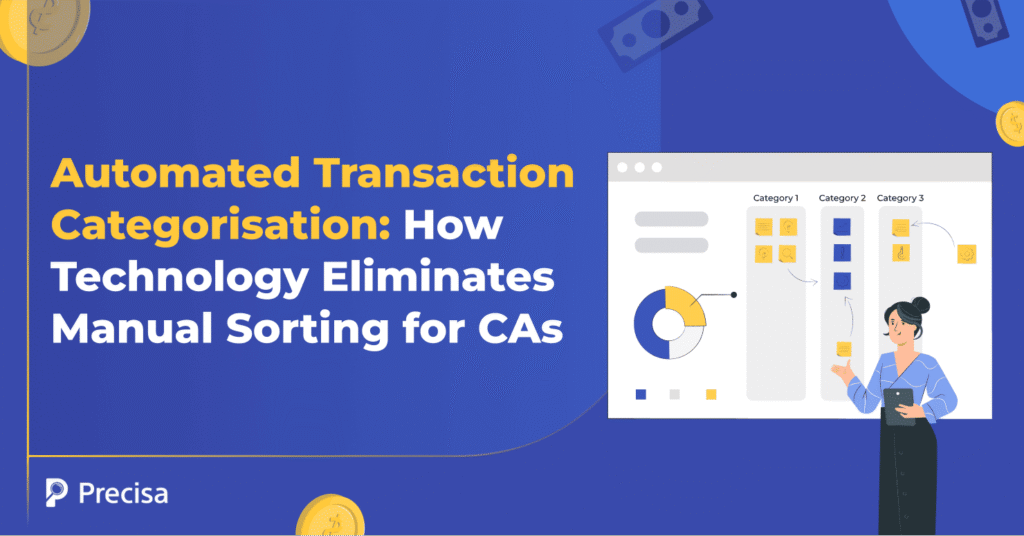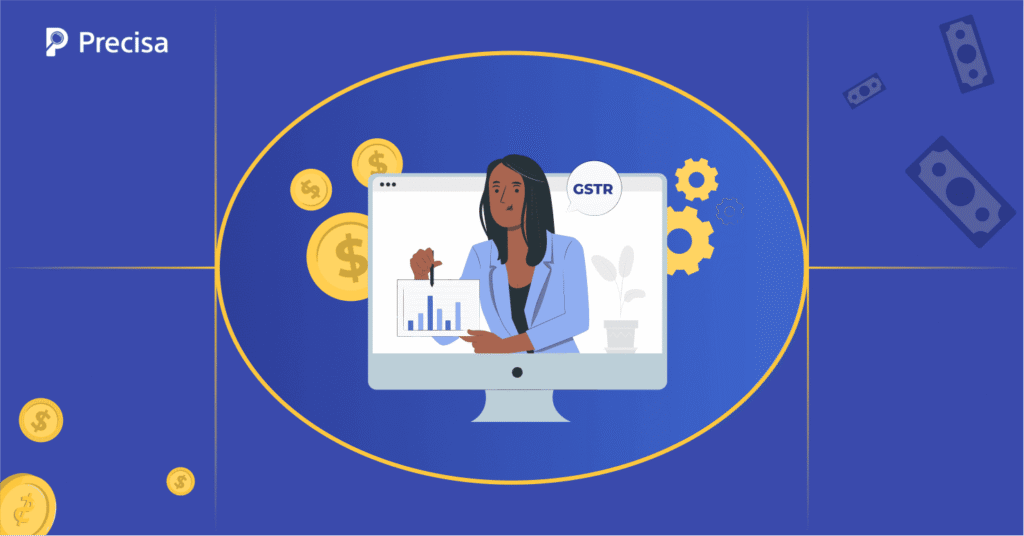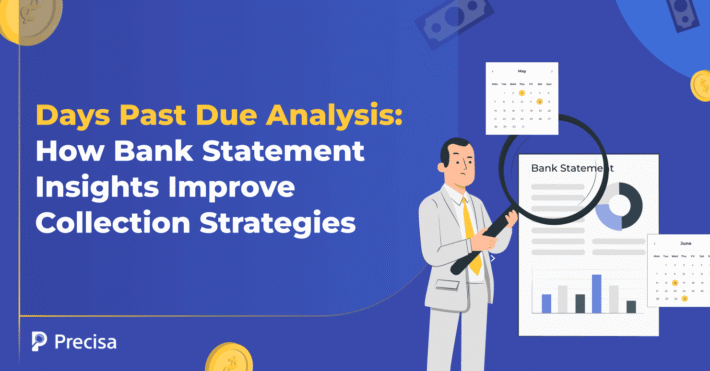How Automated Transaction Categorisation Transforms CA Workflows

For Chartered Accountants (CAs) managing large volumes of financial data, manual transaction categorisation continues to be a time-intensive operational hurdle. It diverts valuable hours away from strategic tasks such as advisory, compliance reviews, and financial analysis.
With the growing complexity of digital payments, multi-account statements, and fragmented transaction narratives, traditional classification methods are no longer scalable.
Finance automation is proving to be a practical solution. Professionals can save 30-40% of their time on routine financial tasks by adopting automation.
Transaction categorisation is a key area where technology can drive immediate impact by reducing manual effort, improving accuracy, and accelerating turnaround.
This article examines how automated transaction categorisation tools, powered by AI and machine learning, are enabling CAs to optimise workflows and concentrate on higher-value engagements.
Limitations of Manual Transaction Categorisation
Most CAs already recognise the friction of handling unstructured bank data. Categorising transactions for reconciliation, compliance checks, or credit assessments typically means reviewing large volumes of entries per client, often spread across PDFs, Excel files, and emails.
The actual cost of this manual process includes:
- Excessive time spent on low-value tasks, limiting bandwidth for interpretation and decision-making.
- Inconsistent classification logic, especially when handled by different team members across engagements.
- Delayed turnaround times, affecting client reporting cycles and reducing responsiveness in time-sensitive matters.
- Compliance exposure, where misclassified items may result in tax inaccuracies, failed audits, or regulatory scrutiny.
Even with pre-built spreadsheet templates, edge cases, ambiguous entries, and frequent data updates often force repeated manual effort. Manual financial data entry and categorisation can carry an error rate of up to 4%, which can be significant when accuracy is critical.
What Is Automated Transaction Categorisation?
Automated transaction categorisation refers to the use of intelligent software to classify financial transactions, particularly from bank statements, into predefined categories such as income, expenses, GST, loan repayments, or internal transfers.
For CAs, it eliminates the need for manual review and tagging of line items across multiple client accounts.
Here’s how the process typically works:
- Data Import: Bank statements are uploaded in PDF, Excel, or image formats.
- OCR Preprocessing: Optical Character Recognition (OCR) tools convert scanned documents into machine-readable text.
- Feature Extraction: Natural Language Processing (NLP) identifies key attributes like remitter, amount, transaction type, and description.
- Model Training: Machine Learning (ML) algorithms are trained over large amounts of categorised financial data to identify patterns.
- Categorisation and Validation: The system auto-tags and verifies each transaction based on historical patterns and context.
- Continuous Learning and Optimisation: With each new dataset, the model refines its accuracy and adjusts to client-specific behaviour.
- Feedback and Oversight: CAs can review and override categories, enabling the system to improve through feedback loops.
This automation brings consistency, scalability, and speed to an otherwise repetitive and error-prone process.
Use Cases Where Automated Categorisation Transforms Outcomes
Beyond basic data clean-up, automated categorisation brings measurable efficiency and intelligence to multiple accounting workflows. Some of the most relevant applications include:
1. Credit Readiness and Loan Advisory
When CAs support clients in applying for working capital loans or credit lines, preparing a clean view of financial inflows, outflows, and cash balance stability is crucial. Automated categorisation simplifies this process by instantly identifying income sources, expense categories, and anomalies, making it easier to assess repayment capacity and generate reports aligned with lender expectations.
This is particularly useful for MSME customers without formal balance sheets or with irregular income streams, where conventional credit scoring falls short. Categorised transaction data provides a better financial portrait for lenders and enables CAs to make more robust applications.
2. GST and Tax Reconciliation

CAs often spend hours separating GST-related payments from general expenses or mapping bank entries to input/output tax liabilities. Automated tools can tag GST inflows, payments, and reversals using pattern matching and contextual cues, considerably reducing effort during filing cycles.
These tools also assist in highlighting transactions with incorrect or missing GST treatment, allowing for proactive correction prior to scrutiny or mismatch notices.
3. Financial Audits and Internal Controls
During internal audits or financial health reviews, categorised bank data simplifies variance analysis, inter-account tracking, and forensic tracing. For example, a flagged “miscellaneous” or large “cash withdrawal” can be immediately isolated and reviewed, rather than lost in hundreds of uncategorised lines.
Additionally, consistent tagging across clients establishes a uniform reporting framework, which facilitates better coordination among audit teams and ensures better transparency in deliverables.
4. Real-Time Client Dashboards and Advisory
Clients increasingly expect more than year-end summaries. Automated categorisation enables CAs to provide quarterly or even monthly financial dashboards segmented by vendor, cost category, or revenue stream.
This positions the CA as a real-time advisor, not just a compliance partner, and opens the door to value-added services like expense optimisation, credit risk flagging, and investment planning based on cash flow insights.
5. Due Diligence and M&A Readiness
In due diligence exercises or valuation mandates, transaction categorisation accelerates the assessment of operational consistency, identifies red flags, and supports segment-wise revenue analysis.
With automation, much of this groundwork is done in hours instead of weeks. It also allows firms to scale their financial review capacity, taking on more such mandates without increasing overhead.
Key Takeaway
As clients scale, diversify payment modes, and demand faster financial insight, manual transaction categorisation becomes a critical drag on practice productivity. Automated categorisation offers a clear path forward, freeing up time from repetitive work, reducing error rates, and bringing consistency to financial workflows.
Precisa offers automated transaction categorisation tools purposely designed for CAs, tax professionals, and finance teams. It supports:
- Automated bank and statement parsing across 500+ banks
- Intelligent transaction tagging under GST, accounting, or audit-relevant categories
- Entity-wise summaries, inflow-outflow mapping, and GSTN validation
- Custom rule engines for unique client scenarios or sector-specific requirements
Precisa’s AI-powered categorisation engine learns continuously from each engagement, increasing accuracy over time. Most firms see value within the first few weeks of implementation, including reduced turnaround time, audit-readiness, and client satisfaction.
Aiming to simplify transaction categorisation and free up your team’s time? Schedule a personalised demo today to see how Precisa transforms transaction workflows for CAs.



